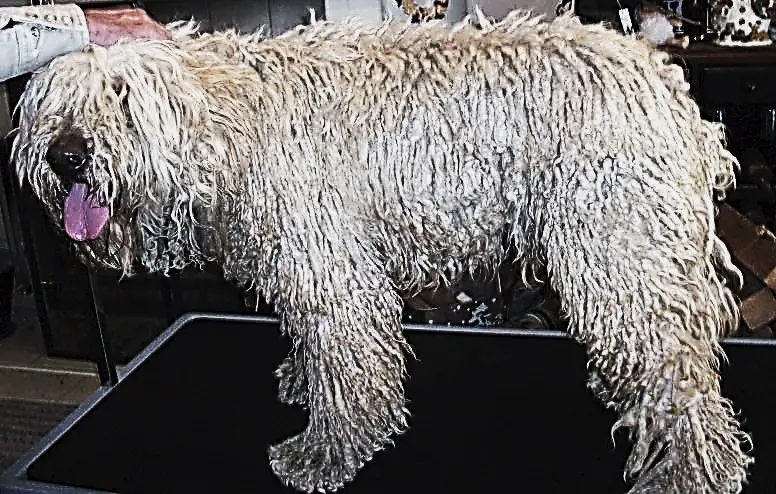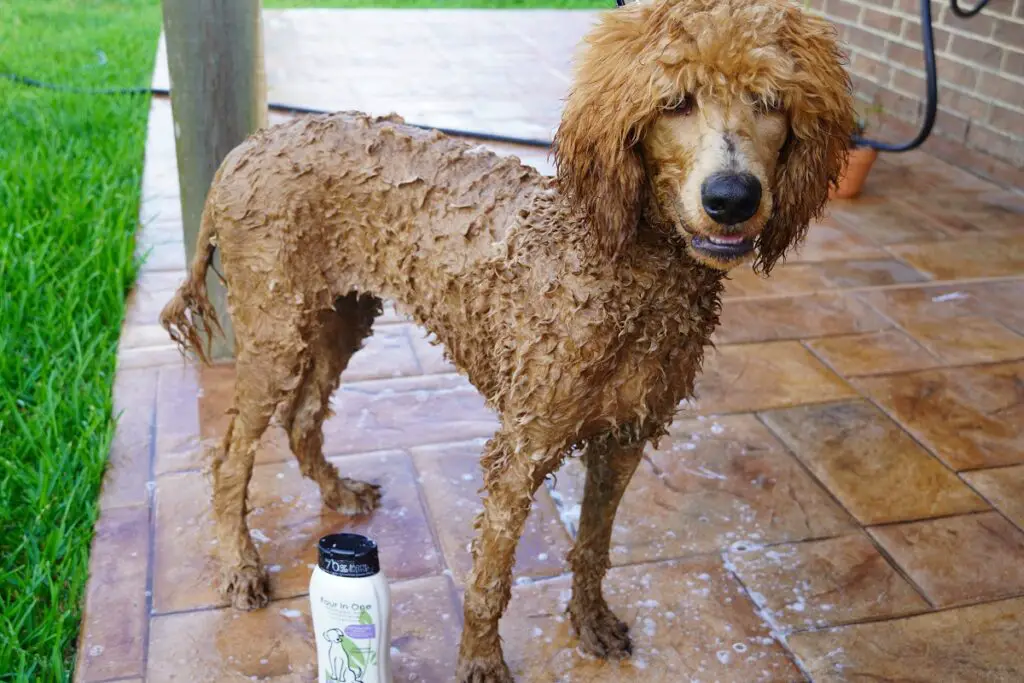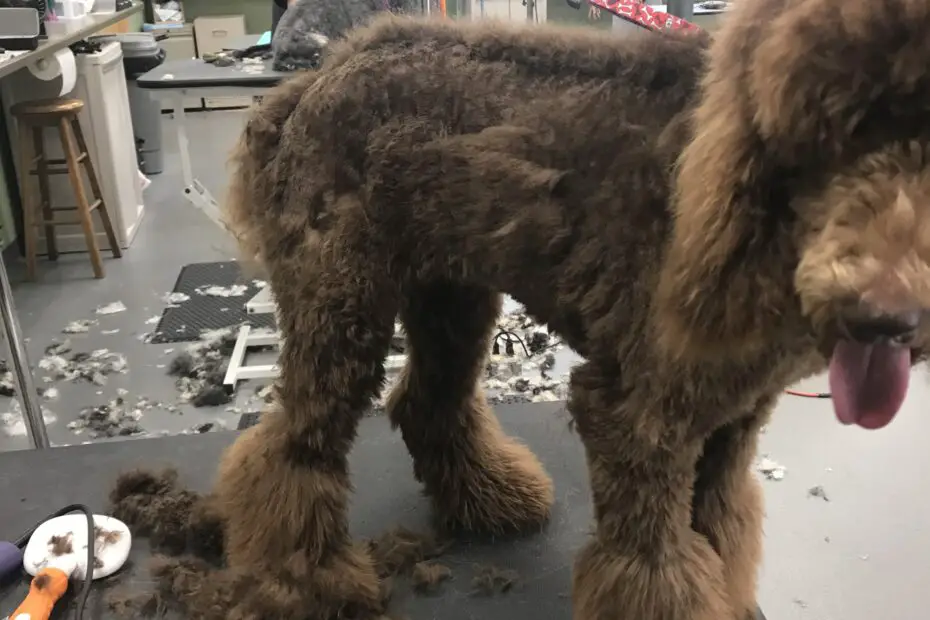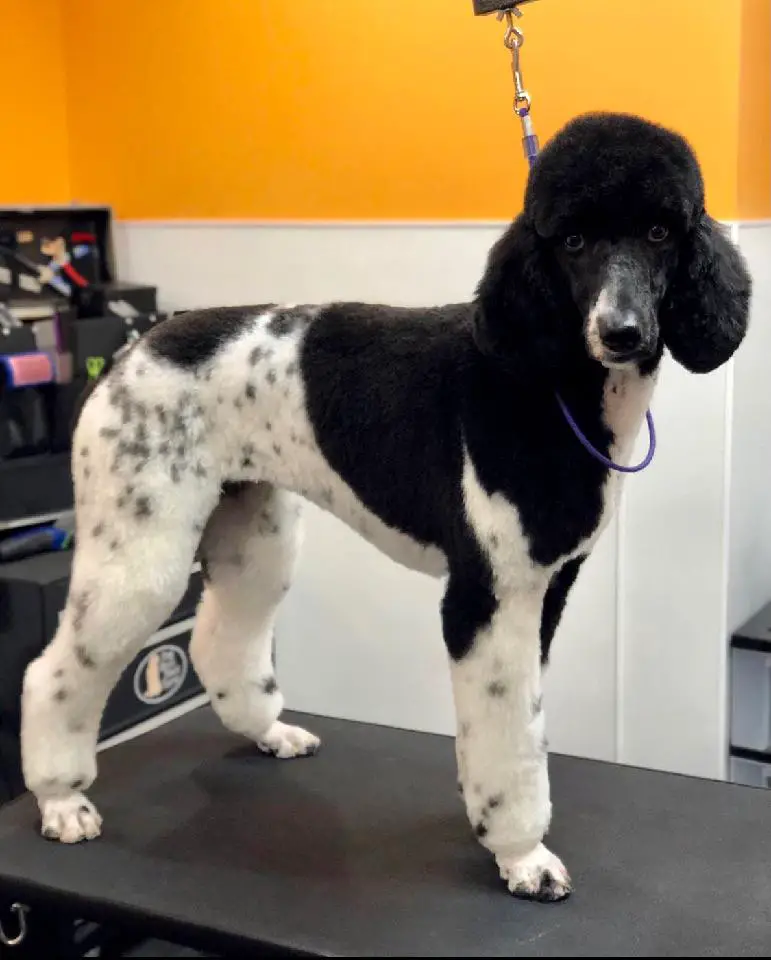Introduction
When we think “show dog”, we imagine the regal poodle with its iconic pom pom coat winning first prize at the Eukanuba Cup. Showstopping, intelligent, loyal, award-winning and that potential show dog is all yours! Now what? You’re looking at that glamorous little wispy haired ball of cute thinking, “Surely it can’t be that hard to groom, right?” And you are absolutely correct! Who has time anyway to take frequent trips to the grooming salon, forking over hundreds of dollars a year to someone else when you could do it yourself? No one will take care of your dog as you do. Plus, home grooming eases the stress off of your pup if bathing and grooming take place in a familiar environment.
The Importance of Grooming Your Poodle and How Often You Need To
Many people don’t know that poodles don’t have fur. Like humans, they are covered in hair which gives them the amazing attribute of being hypoallergenic. Click here to read our article on how poodles are hypoallergic.
With only one coat, as opposed to the standard two coats possessed by most dogs, they don’t shed. Unfortunately, this means their hair, like ours, continues to grow and they require higher maintenance and upkeep than their two coated cousins.
As their hair grows, mats can occur if daily brushing is not upheld. Besides unsightly knots in your dog’s beautiful coat, mats can tangle the hair so close to the skin that it induces severe circulation issues. Without proper blood flow, the skin loses oxygen and begins to die, causing sores and further pain to the dog.

Along with daily care comes being vigilant for a variety of skin problems common to poodles. This can include, but is not limited to:
- Allergies
- Sebaceous Adenitis
- Cushing’s Disease
- Pyoderma
- Alopecia
It is important to note here that there are a number of diseases that can be detected from the daily care of your pet. While not necessarily a skin disorder, Cushing’s Disease is an example of such illnesses. Hair loss, rashes, and dandruff can be an indication of larger, underlying issues. Besides keeping your best friend looking like a star, frequent grooming and upkeep can help you stay on your toes in regard to his or her health.
So how often is “frequent” care and upkeep? We recommend full grooming every 3 to 6 weeks with daily brushing and combing. Remember, poodles don’t have fur! Just like you wouldn’t want to go a month or two without a shower, your pup probably doesn’t either. Assuming you aren’t using your poodle as a hunting partner or letting them do mud romps (not like this poodle 🙂 ), a bath every couple of weeks should be just fine. Be sure to give a good brush down before the wash-up, taking care to remove all of the tangles and knots.
Popular Poodle Haircuts
Now we will take a look at the hairstyles common to the poodle. We have grouped these styles based on the difficulty level associated with each cut. As we said before, if you’re new to grooming your poodle, take it easy. Experienced groomers and professionals can be more adventurous. Everyone has to start somewhere. If things don’t turn out how you envisioned the first time, that’s alright! Keep practicing and soon you too will be able to give your pup a more personal touch to their style.
Starting with easiest to most challenging cuts, here is a list of the poodle’s top 10 contemporary styles:

10. Kennel Cut
9. Dutch Cut, or Sporting Cut
8. Puppy Cut
7. Town and Country Cut
6. Miami Cut
5. Jackets and Pants Cut
4. Teddy Bear Cut
3. Continental Cut
2. Lion Cut
1. English Saddler Cut

Before Teddy Bear Cut 
Teddy Bear Cut
Styles such as the Teddy Bear Cut can appear deceptively easy. However, some of these styles require advanced skill with scissors and shears to achieve the desired look. Tips and techniques to help guide you will be touched on throughout this article.
Home Grooming
Doing a complete grooming at home can be quite a task, but if you have a do-it-yourself nature, you might want to learn how. Not only is home grooming less expensive, people who enjoy grooming their poodles often build an even closer bond with them.
If you think you`d like to try grooming your own poodle, you will need to learn how to shave and scissor your poodle, and learn which blades to use. If you don`t have any friends who groom poodles, try to find a professional groomer who is willing to teach you, enroll in an adult-education or correspondence course or buy a grooming video or book.
A lot of work goes into making a poodle look like a poodle. Grooming is time-consuming and requires patience, and your poodle may have some “bad hair days” as you learn and become more comfortable with the grooming techniques. Remember, no mistakes are permanent, poodle hair always grows back.
You will have to invest in good-quality scissors and electric clippers. A grooming table with a nonslip surface is helpful, or use a steady table with a nonslip bath mat. Poor equipment can cause injury to your poodle, so your grooming tools (clipper blades, brushes, combs, and nail clippers) should be in good condition and replaced when necessary. A terrific book that explains the grooming process is “Poodle Clipping and Grooming” by Shirlee Kalstone.
Important Factors to Consider when Choosing Poodle Clippers
Before diving into the finer details of grooming, you must first consider the tools you will use. One of the most important items in your inventory will be the clippers. You may be tempted to reach for your own clippers before doling out the cash for a new piece of merchandise. While poodles do have hair and not fur, they still require the special clippers made for dogs. So what is the difference?
First and foremost, human clippers possess a much stronger motor that can be unpleasant for a dog. The intense vibration and noise can be alarming, making for a highly stressful experience. Second, the teeth on the blades of human clippers are closer together. The dog’s denser coat can get jammed, catching in the blades which results in pain and possible injury of the dog. Between the intensity and ill-suited blades for cutting, abrasions and irritation are much more likely to occur. Clippers for dogs are equipped with a lighter motor, sharper and wider teeth, with various kinds of blades depending on the type and style of grooming.
With all of that having been said, investing in a good pair of clippers is in you and your dog’s best interest. There are many options available to you that are perfectly fitted to suit your needs. We will help you analyze the best clippers for value, durability, noise, efficiency, corded or cordless, ease of use, and heat output.

Value, noise, and durability
The first step in choosing your new clippers is deciding what general look you will want to go for with your poodle. If you ultimately want show coat quality, the value may be lower on your list. Do you want a higher degree of precision? Perhaps consider a clipper with various speeds and multiple blades. If your pup has higher levels of anxiety, aim for a quiet motor. When researching potential clippers, read the reviews. How reliable are the clippers? How long do they last? Weigh your options regarding what you want out of your new set of clippers.
Efficiency
Here is where you want to truly consider power and speeds. Clippers can have 1 to 3, or more, speeds. Professional groomers are generally equipped with 3-speed clippers. As a DIY poodle groomer, you likely will not need more than 2 speeds. Lower speeds and more power are helpful for thick coats and possibly matted dog fur. With only one coat, no undercoat, and thinner hair than most breeds, lower speeds for poodles are unnecessary. That having been said, a trimmer with more than 1 speed can come in useful when taking on more difficult styles.
Corded versus Cordless Clippers and Ease of Use
When considering ease of use, you will want to examine the pros and cons of corded versus cordless clippers. Cordless clippers are battery-operated, available with recharge options. How often will you be grooming your poodle and where? Smaller poodles are easier to groom inside thus putting you closer to a power outlet. If you have an energetic standard that can’t seem to sit still for longer than five minutes, then you may not want a cord to get tangled up in.
Heat Output
This goes hand in hand with, not only power and efficiency, but corded or cordless. If you will be using a clipper for longer periods of time and more often, energy consumption and heat output should be considered. A cheaper, high powered, cordless clipper can overheat and be hard on battery life. Hot blades and clippers can also burn your dog’s skin. Ensure that you monitor the heat being generated by the clipper you chose. Take precautions and have means nearby to cool the item down. A good option is to purchase a cooling lubricant for the clippers.
Professional Grooming
Choosing A Professional Groomer
You want a gentle groomer who doesn`t speak harshly, likes your dog and who seems to enjoy the animals she/he grooms. You also want a groomer who listens to what you have to say about your dog’s haircut.
When it comes to selecting a groomer, word of mouth is important. Keep your eye out for well-groomed poodles, when you see one, ask the owner who their groomer is. Ask your friends, family, veterinarian and breeder.
Visit the groomers you are considering, assess the general environment, cleanliness and noise-level of the shop. Pay attention to how the groomer interacts with the dogs.
When going to a groomers, it`s can be natural for your poodle to be a little distressed about being left behind by you.
In Between Full Groomings
Even if you take your poodle to a professional grooming there are some things you will have take care of at home.
Brushing Your Poodle
Brushing is essential to keeping the Poodles coat tangle free and prevent matting. It helps to distribute the skin’s natural oils, increases skin circulation and it feels good to your Poodle.
The time you spend brushing your Poodle increases the bond between you and your dog. This is also a good time to check your dog over for sores, skin inflammation, and lumps.
Poodles do shed some, but the loose hair stays in the coat and mats rather than falling out.
A thorough brushing and combing twice a week is usually sufficient. First put your Poodle on a non-slip surface. Start brushing at the hindquarters, move to hind legs, front legs, body, and then to the head and ears.
A slicker brush is needed to pull dead hairs and mats out of the Poodles coat. A pin brush is preferred for the ears, topknot, or any other long areas because they are less likely to tear or break the hair.
After your Poodle is brushed, use a metal comb to detect snarls that may have been missed.
Bathing Your Poodle
Poodles can be bathed as often as once a week. Bathe the Poodle in warm water and use a mild dog shampoo.
Once your dog is in the tub, saturate the dog with warm water. Make sure your Poodle is wet to the skin. Poodles have a dense coat and were bred as water dogs so this may take several minutes.
Shampoo twice and rinse thoroughly, leaving any shampoo residue in the coat irritates the skin. Using a conditioner is recommended for a poodle with sensitive skin and can be helpful in getting all the shampoo out of the coat.
Left to air dry the Poodle`s coat will be curly. For a smooth fluffed look, brush with a soft slicker brush or pin brush as you are drying with a blow dryer.

Caring For Your Poodles Ears
The Poodle grows hair inside the ear canal which can block air flow and result in infections.
There are many opinions regarding ear care, from removing all the hair in the ear to not removing any hair at all. Follow your veterinarian’s or breeder’s advice. Many recommend removing most of the hair to increase air flow and prevent infection.
If it is recommended to you to remover the hair inside the ear, using an ear powder makes the ear hair easier to grab and remove. Apply a small amount of ear powder inside the ear. Hold the ear flap back with one hand while you gently pluck the hair with your thumb and forefinger of your other hand.
After you have pulled the ear hair, wipe the ear out with a dry cotton ball, or one slightly moistened an ear cleaner product available from your veterinarian or from your groomers.
Healthy ears are clean, free of debris, without odor, and will not need a lot of cleaning.
Cleaning a dirty ear, one that is filled with wax or debris, does require some looking after. Dampen a cotton ball with an ear cleaner (available at your vets or groomers). Hold the ear flap with one hand and wipe with the other. Wipe gently into the ear and wipe out all crevices and folds. It may take several cotton balls. Check your Poodle’s ears often to ensure they are clean and healthy. If in doubt, please seek advice from your Veterinarian.
Check Your Poodles Eyes Daily
Tear stains caused by excessive tearing can occur in Poodles. In light colored Poodles the staining appears reddish brown.
Wiping your poodle eyes every day can minimize tear stains and prevent matter from building up and hardening, causing irritation and sores.
With a water moistened cotton ball, gently wipe the corners of eyes to remove tears and debris. If you notice redness, inflammation, or cloudiness, please call your veterinarian.
Dental Care Is Important
Your Poodle needs dental care – regular, professional care from your veterinarian, as well as care at home from you.
Dogs teeth need to be cleaned at least once a week, although daily is better. Wipe the teeth with a soft cloth, gauze or use a soft bristled toothbrush and doggy toothpaste.
Clipping Your Poodles Nails
How often your Poodles nails need trimmed varies with the dog. It is best to keep the nails clipped so they do not touch the ground when your poodle is standing.
Over-grown nails that touch the ground, put pressure on the base of the nail and can be painful. In any dog, exceptionally long nails can distort the paw, causing pain with every step.
There are several types of nail clippers, small or medium-size clippers work well for Toy and Miniature Poodles, large or heavy-duty are better suited for Standard Poodles.
It is a good idea to have styptic powder, in case you clip too close and the nail bleeds. To trim the nails, hold the paw firmly in one hand. Place your thumb on top of the foot and fingers underneath to spread the toes.
With your other hand, clip the nails, one at a time. Remove any sharp edges with a few swipes of a file.
At first, you may want to trim only the nail tips to avoid cutting down to the quick. If you cut the nail too short or the quick has grown too long, your Poodle may yelp, but try not to panic. Keeping hold of the paw, apply styptic powder to the bleeding nail and press. Hold until bleeding stops.
Basic tools needed for Regular Maintenance Grooming
- Slicker Brush
- Pin Brush
- Comb
- Ear Powder
- Ear Cleanser
- Nail Clippers or Nail Grinder
Final Thoughts
Poodles require frequent grooming. Keep an eye on your poodle and its coat. If you feel they could use a trim. Take them to a professional groomer. Also, you can learn to groom your poodle yourself. While you don’t have to follow anyone else’s schedule, be mindful of what is a healthy and reasonable length for your poodle`s hair. Ensure to take care of mats and tangles as they come up, especially in the chest area.
Do your own research on different coats and styles. There are tons of different looks we did not cover. You could invent one yourself! Who knows! Your pup’s new look could be the new rage at all the dog shows.


